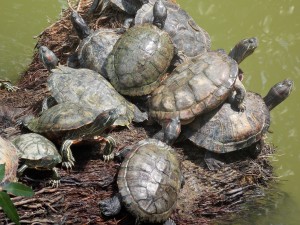Titillating Turtles!
I decided to do more research on the interesting display of behavior observed during my fieldwork on Red-Eared Sliders, Trachemys sciprta elegans, regarding an unrelated behavioral phenomenon. Take a look at the Titillating display here! Sources indicate that there are a variety of ways in which the Slider Turtle species, Trachemys scripta, performs its courtship! These include trailing, orientation and titillation (Lovich et al, 1990). Trailing refers to the chasing of the female turtle by the male, with its nostrils directed towards her cloacal region (her butt!), while orientation refers to the positioning of the male turtle to face the female by swimming backwards in the water, and titillation refers to the moving of the male’s foreclaws towards the head of the female and vibrating them quickly. Both orientation and titillation can be observed in the video I took during my group’s fieldwork!
Additionally, other subspecies of the Slider turtle, Trachemys scripta, have different specialties in their courtship repertoire. For example, the Cuatro Cienegas Slider, Trachemys s. taylori, mainly uses biting as a form of courtship, and males of the Ornate Slider (Trachemys s. ornata) and the Gray’s Slider (Trachemys s. grayi) have been reported to spray water through their nostrils at the female (Lovich et al, 1990)! In the case of the Pond Slider, Trachemys s. scripta, the roles are reversed in that the females are the ones who have been observed performing the titillating actions on the males, instead of the stereotypical male performance (Thomas and Altig, 2006).
Other studies also show that titillating behavior is more commonly performed by the younger males of the species, indicated by their non-melanistic colouring, while biting and chasing are more commonly performed by the older melanistic males (Thomas, 2002). The term ‘melanistic’ refers to the black pigmentation of the skin, which, in the case of the slider, is related to the age of the turtle i.e. older turtles tend to be melanistic while younger turtles tend to be non-melanistic. It has also been found that melanistic pigmentation sets in at approximately the same period as when the growth of the foreclaws stop, suggesting that the importance of titillation as a courtship display decreases with an increase in the age and size of the male turtle (Thomas, 2002).
P.S.
What is interesting about these observations is that there are a multitude of strategies of courtship for the same species of turtle, and cases where there are specialized behaviors for particular subspecies. There is also a variation of activity that is related to the age of the turtle, and at times a reversal of gender roles. On a personal level, I cannot help but notice how similar this is to the courtship behavior of humans. Most of the time, the average person regards an animal as an animal and forgets that it too has an age, a gender, and a race. As students of animal behavior, I think that it is important that we keep these aspects in mind as we gaze upon our subjects of study.

